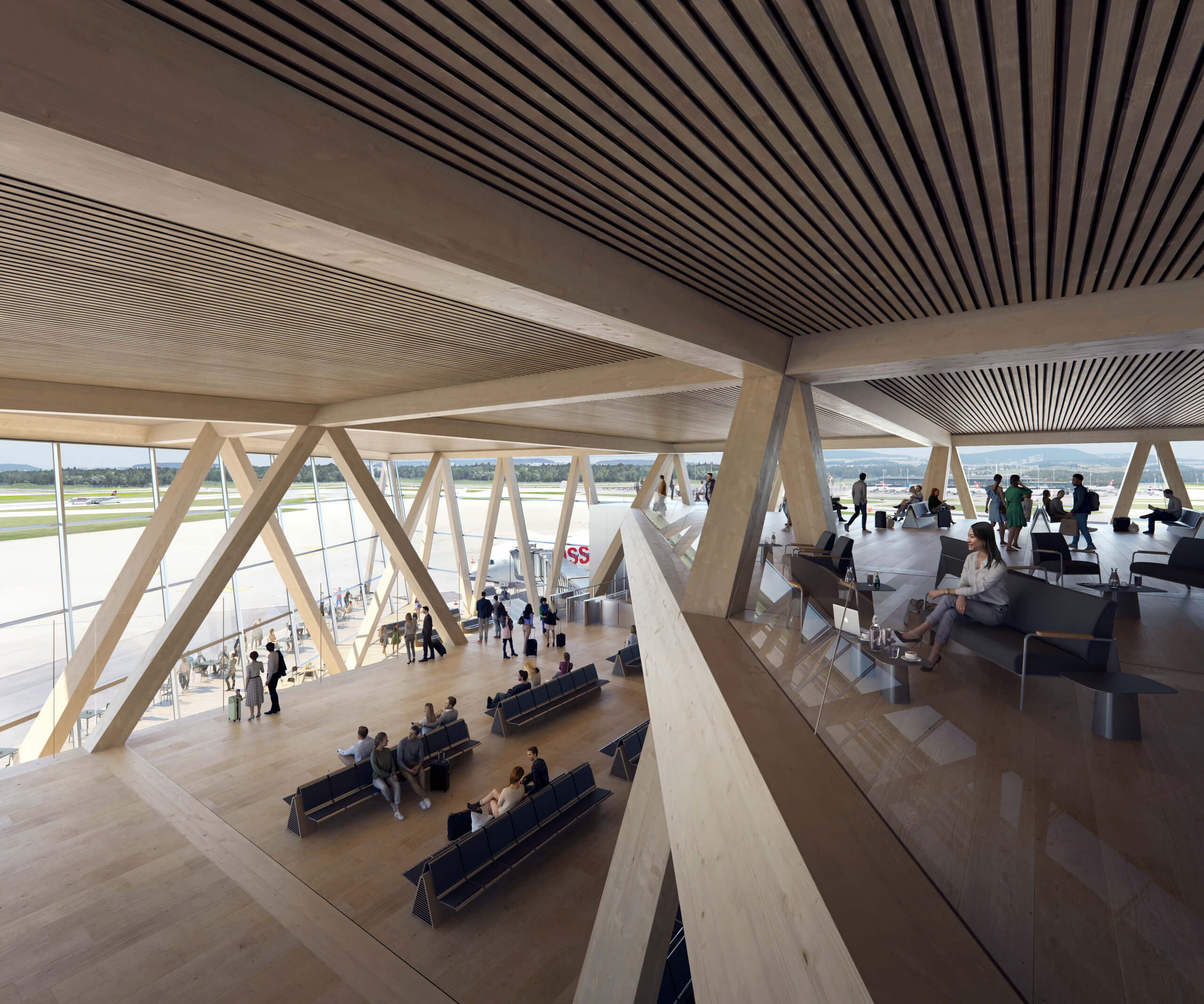An international design team led by Bjarke Ingels Group (BIG) and St. Louis-founded global practice HOK—in the roles of design lead and aviation architect, respectively—have triumphed in a two-stage design competition seeking proposals for a new Dock A at Zurich Airport. Located several miles north of central Zurich, the airport is the largest international airport in Switzerland and the main hub of flag carrier Swiss International Airlines. Per a press announcement from BIG, the overhaul of the existing Dock A main terminal facility—a local timber-heavy affair that includes new Schengen and non-Schengen gates, retail, lounges, offices, a new air traffic control tower, and an extension of the airport’s existing immigration hall—aims to “strengthen the airport’s continued status as the gateway of Switzerland.”
Described by Bjarke Ingels, founder and creative director of BIG, in a statement as “a simple yet expressive design—rooted in tradition and committed to innovation—embodying the cultural and natural elements of Swiss architecture,” the future new terminal follows a handful of major new additions to the 74-year-old Zurich airport including the satellite Terminal E and the Airside Center, a multi-building passenger center-slash-shopping mall-slash-parking complex. Both were completed in 2003. Opening opposite the Airside Center in 2020 as the largest Swiss commercial development project to date was The Circle, a massive $1.3 billion mixed-use complex designed by Riken Yamamoto that features a hotel, convention center, and hospital. The winning team has dubbed the Dock A proposal as Raumfachwerk, a German word that, in the words of BIG, can be used to describe a “robust yet flexible structural framework.”

“The name says it all: Space and structure get fully integrated and result in a highly functional and flexible design,” remarked jury chair, the Basel-based architect and educator Harry Gugger. “The backbone of the project is formed by a structure that is not just load bearing, but defines and adapts the space, creates a unique atmosphere, and provides a distinctive identity true to its place and era.”
“This project marks not only a new milestone for Zurich Airport but for the entire aviation,” added Gugger, noting the jury was “delighted and grateful to endorse such a groundbreaking project that will help to revive sustainable wood construction for great infrastructural projects.”


Joining BIG and HOK on the winning team are Buro Happold (structural engineer), 10:8 (local architect), Pirmin Jung Schweiz AG (structural engineer timber/building physics), NACO (aviation consultant), Haerter & Partner AG (mechanical engineer), TLP (electrical engineer), and others. The team’s vision won out over 10 other proposals from a blockbuster roster of firms vying for the project, including Foster and Partners, Grimshaw Architects, and SOM. The win marks the second major European project secured out of closely watched competition by BIG in a matter of weeks, following last month’s selection of the firm’s proposal for the future Vltava Philharmonic Hall in Prague. HOK has helmed numerous airport and transportation infrastructure projects, including the lauded new Terminal B at Laguardia Airport in New York, a major expansion of Terminal D at Chicago O’Hare, and the new Salt Lake City International Airport that debuted in 2020.
“As airports grow and evolve and as international guidelines and safety requirements change, airports tend to become more and more complex: Frankensteins of interconnected elements, patches and extensions,” said Ingels. “For the new main terminal of Zurich Airport, we have attempted to answer this complex challenge with the simplest possible response: A mass timber space frame that is structural design, spatial experience, architectural finish, and organizational principle in one.”

In addition to an abundance of locally sourced prefabricated wood elements, including the building’s floors, ceilings, and V-shaped timber columns that provide “a structural function while also serving as a reference both the iconic Swiss alpine landscapes and the centuries-old tradition of timber construction and traditional pitched roofs,” other notable elements of the new Dock A are set to include a solar shingle-clad roof with integrated shading, sustainable cooling and heating systems, and a soaring, natural light-flooded central atrium that serves as the connective tissue between all seven floors, from the subterranean immigration to the upper-level lounges, of the complex. The new air traffic control tower will be placed at the center of the new structure, “experienced from the inside as a beacon that creates a sense of place, akin to a town square rather than an airport,” according to the team.
Per Zurich Airport, construction on the new Dock A at Zurich Airport is slated to commence in 2030. The existing Dock A, located just to the north of the planned new facility accommodates roughly one third of arriving and departing passengers, and will remain open as usual while work on the new terminal is underway. It will be dismantled once the new facility is opened.











